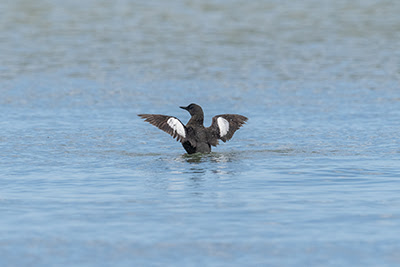Black Scoter is the American equivalent of our Common Scoter. The 1st UK record as late as 1987. Up until 2022 there had been 16 UK records including the long staying bird at Llanfairfechan that I saw in 2003 and 2004.
Roll on 21 years and I was just about to go on holiday in Tenerife with Sean O'Hara posted a photo of a Black Scoter he'd found off the north Wirral coast at Hoylake. It was quite obviously a male Black Scoter and was associating with the large number of Common Scoter present in the area over the winter.
All week I saw reports coming out on the bird news services and local WhatsApp groups of the Black Scoter being seen and was hopeful it would still be there on my return. Unfortunately the day after we returned I had to wait in at home for an engineer to come and fit full fibre broadband so had to wait yet another day.
Meeting up with Al we parked up and walked across to the RNLI station where we saw a few other birders forlornly looking out to sea not realising as the tide was dropping they could follow it out. We set off like a pair of Pied Pipers with the others following behind. Out at the tides edge we gradually moved further forward as the sea continued to recede.
With a stiff breeze blowing the sea was quite choppy but we soon picked up the Black Scoter - especially when the sun shone and reflected off its huge yellow conk! It stuck out like a beacon. For the next couple of hours there followed a game of hide and seek as we advanced to the edge of the tide and the bird disappeared temporarily in the waves before popping up again.
A great bird to see in our area following Surf Scoter a few years ago. As well as the Black Scoter we had the added bonus of 2 Long-tailed Ducks and 4 Scope.
 |
| Black Scoter twitch |
With the wind numbing our fingers (despite gloves) we decided to call it a day and walk the long way back to the shore and warmth. Another superb find by Sean O'Hara on his local patch. From Seans photo the orange tinge to the base of the upper mandible can clearly be seen. Interestingly the Black Scoter always seems to be in the closet group of Scoter just beyond the surf line and the late Martin Garner, in his Frontiers in Birding book (published 2008, ISBN 978-1-898110-47-7) notes that Black Scoter, in N America, quite often feed in the surf.








































































